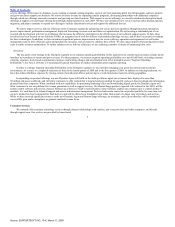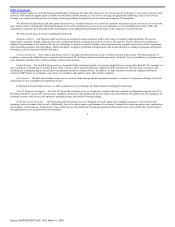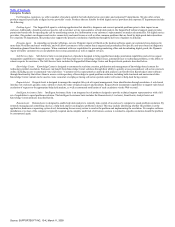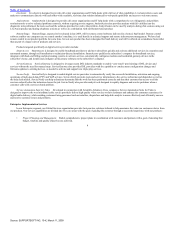Support.com 2008 Annual Report Download - page 18
Download and view the complete annual report
Please find page 18 of the 2008 Support.com annual report below. You can navigate through the pages in the report by either clicking on the pages listed below, or by using the keyword search tool below to find specific information within the annual report.
Table of Contents
successfully. We have limited experience in reaching or serving consumers and in managing technical support agents. All of our North American technical
support agents are now home-based, which will require a high degree of coordination and quality control of employees working from diverse and remote
locations. As a result, we expect to continue to use significant cash and incur increased operating expenses to support this initiative, including costs associated
with recruiting, training and managing our technical support agents, costs to develop and acquire technology and infrastructure to support our Consumer
business, promotional costs associated with reaching consumers, and costs of obtaining personnel with the necessary consumer expertise. These investments,
which typically are made in advance of revenue, may not yield increased revenue to offset these expenses. Furthermore, this new business initiative, if not
favorably received by consumers, could damage the reputation of our Enterprise business as well as strain our management, financial and operational resources
necessary to maintain our Enterprise business. The lack of market acceptance of our Consumer efforts or our inability to generate satisfactory revenue from our
expanded consumer services would have a material adverse effect on our business, prospects, financial condition and operating results.
Our failure to establish and expand successful third-party alliances to sell our products and services would harm our operating results.
Our Consumer offerings require us to establish and maintain relationships with third parties, including retailers such as Office Depot, who market and sell
our premium technology services. Failure to establish or maintain third-party relationships in our Consumer business, particularly with firms that sell our
services, on acceptable terms or at all, could materially and adversely affect the success of our business. We sell to numerous consumers through each of these
channel partners, and therefore a delay in the launch or rollout of our Consumer services program with even one of these channel partners could cause us to miss
revenue targets. The process of establishing a relationship with a channel partner can be complex and time consuming, and we must pass multiple levels of
review and test marketing in order to be selected. If we are unable to establish a sufficient number of new channel partners on a timely basis our sales will suffer.
There is also the risk that, once established, our programs with these channel partners may take longer than we expect to produce revenue or may not produce
revenue at all. One or more of our key channel partners may also discontinue selling our services, offer them only on a limited basis or devote insufficient time
and attention to promoting them to their customers. If any of these key channel partners merge with a competitor, particularly one that offers a service
competitive with ours, all of these risks could be exacerbated. Each of these risks could reduce our sales and significantly harm our operating results.
We also have alliances with third parties that are important to our Enterprise offerings. Our existing relationships include those with hardware vendors and
managed service providers who provide outsourced support to corporate customers. If these relationships fail, we may need to devote more resources to the sales
and marketing of our products and services than we would otherwise, and our efforts may not be as effective. In addition, we may establish relationships with
third-party resellers and other sales channel partners as we expand internationally. Our failure to maintain existing relationships, or to establish new relationships
with key third parties, could significantly harm our ability to sell our products and services. In addition, our competitors may have strong alliances with other
companies, including hardware providers, which could impact our ability to obtain greater market share, participate in deals where hardware and software are
sold together, or require us to reduce the price of products and services, which could harm our business, prospects, financial condition and operating results.
Our inability to meet future financial performance targets that we announce or that are published by research analysts could cause the market price of
our common stock to decline.
From time to time, we provide guidance related to our future financial performance. In addition, financial analysts publish their own expectations of our
future financial performance. Because our quarterly revenue and our operating results fluctuate, future financial performance is difficult to predict. In the past, we
have failed to meet our guidance. As it did following the announcement of our third quarter results in 2007, future downward
15
Source: SUPPORTSOFT INC, 10-K, March 11, 2009
























